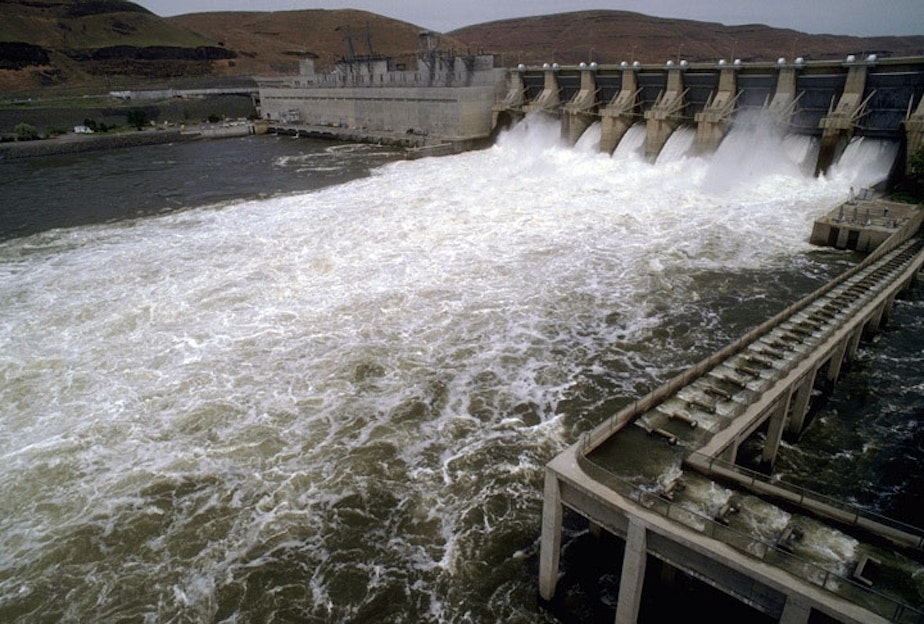Federal regulators to limit hot water in Snake, Columbia rivers

Federal regulators starting this spring will require dam operators to limit hot water pollution caused by the four Lower Snake River dams.
Large reservoirs behind dams contribute to elevated water temperatures that can be harmful to fish, according to environmental groups. Summer water temperatures that spike above 68 degrees Fahrenheit can kill migrating salmon and steelhead.
Climate change and dam impacts are the main causes of high water temperatures in the lower Columbia and Snake rivers, according to the U.S. Environmental Protection Agency.
The permits, set by the EPA, limit the amount of warm water federal dam operators can release each month on the Lower Snake River. In addition to limiting the amount of warm water, the U.S. Army Corps of Engineers will collect and report temperature data at the four dams.
By lowering water temperatures a few degrees, these limits could help salmon hang on a little longer, said Miles Johnson, senior attorney with Columbia Riverkeeper, an environmental group.
Sponsored
“It’s really the difference of salmon being able to survive their migration through the Lower Snake River or not,” Johnson said of temperature limits that could slightly cool river water.
Efforts to lower water temperatures could include drawing down reservoirs or moving more water through the Snake River, Johnson said.
In 2013, Columbia Riverkeeper sued the Army Corps, which operates the four Lower Snake River dams. The environmental group sought to limit pollution at the dams.
After a settlement with Riverkeeper, the Army Corps applied for permits from the EPA in 2015.
However, the EPA delayed issuing the permits after Washington state regulators sought compliance with state temperature standards at nine federal dams.
Sponsored
The EPA’s temperature permits will take effect April 1, 2022, and will last for five years.
Overall, the permits will require the temperature on the Snake River to be lowered by around 5 degrees Fahrenheit to meet water quality standards, although temperature reductions will vary by time of year and dam location.
Climate change has increased summer water temperatures on the Columbia and Snake rivers by around 2.7 degrees Fahrenheit since the 1960s, according to the EPA. The agency said it expects this warming trend to continue.
In addition, water held in reservoirs can raise river temperatures for various reasons, depending on the time of year and dam operations, according to the EPA. In the summer, reservoirs can lead to sustained higher river temperatures, higher temperatures in fish ladders, and higher temperatures in surface water, according to the EPA.
Higher temperatures at each Snake River dam adds up. That means the warmest water is measured at the river’s farthest downstream dam. The EPA estimated water at Ice Harbor Dam, near the Tri-Cities, increases nearly 4-degree Fahrenheit in the late summer.
Sponsored
However, deep reservoirs can cool river temperatures, as dam operators release cool water stored far below the surface.
The Army Corps has already taken some steps to lower water temperature on the Snake River.
Beginning in early summer months, the Army Corps releases cold water from Dworshak Dam on the North Fork of Clearwater River in Idaho. The cold water then flows into the Snake River, which lowers temperatures as salmon migrate upstream to spawning grounds.
These releases significantly cool water at the confluence of the Snake and Clearwater rivers near the Idaho-Washington border, according to the EPA. For example, the EPA estimates cold water releases drop river temperature by around 6.8 degrees Fahrenheit in August.
That drop in temperatures helps at Lower Granite Dam, the first dam downstream of the cold water releases. However, the cold water benefits diminish at each downstream dam, according to the EPA.
Sponsored
The Army Corps installed fish ladder cooling systems at Little Goose and Lower Granite dams, the final two dams fish must travel through on the Snake River. Cool water is pumped from deep in the reservoirs into fish ladders, which helps adult salmon swim up the ladders.
The Snake River historically experienced warm water temperatures before the dams were built, according to the Army Corps.
However, Johnson said, more needs to be done to help fish survive. In fact, he said, these temperature permits could highlight the need to remove the Lower Snake River dams.
“Reservoir drawdowns and moving more water through the river could, frankly, be disruptive to hydropower and transportation,” Johnson said. “As a region, we should take this opportunity to step back and say, ‘Can we come up with a more holistic solution?’”
That could mean removing the dams and replacing the power, transportation and irrigation that dams currently provide, he said.
Copyright 2021 Northwest News Network



